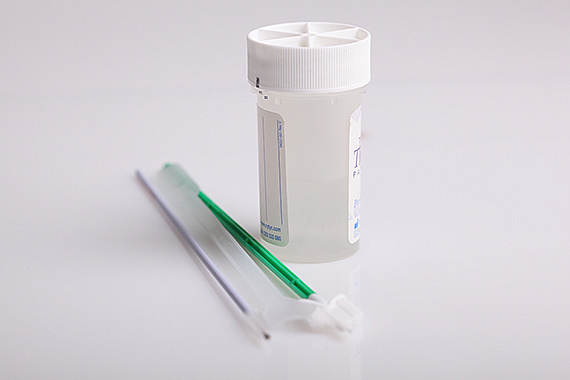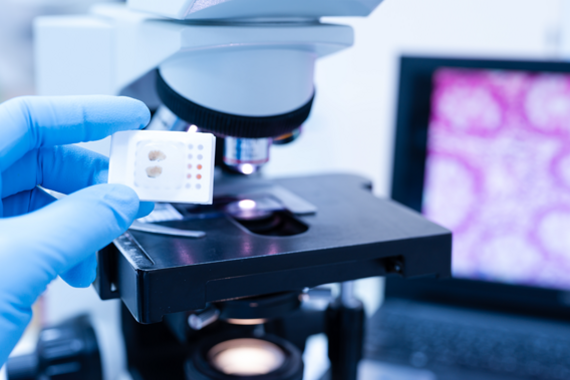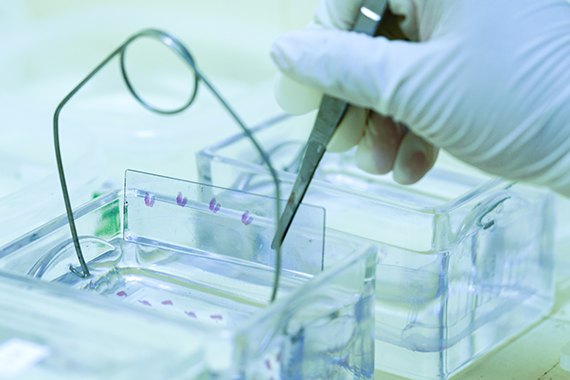-
The University
- Welcome
- Who we are
- Media & PR
- Studying
-
Research
- Profile
- Infrastructure
- Cooperations
- Services
-
Career
- Med Uni Graz as an Employer
- Educational Opportunities
- Work Environment
- Job openings
-
Diagnostics
- Patients
- Referring physicians
-
Health Topics
- Health Infrastructure
Pathology for interested
Your pathologist
- assists you in taking action to prevent cancer
- provides the basis for decision-making regarding your therapy
- helps ensure the quality of your treatment
Führungen
Das Diagnostik- und Forschungsinstitut für Pathologie bietet für interessierte Gruppen (ab sechs Personen) z.B. Schüler*innen, Absolvent*innen etc. Führungen an. Dabei werden die Aufgaben der Pathologie und ihre Bedeutung für die Medizin in Forschung, Lehre und Patient*innenbetreuung erläutert.
Kontakt

Austria's pathologists: Committed to life!

Cancer screening: Modern pathology saves lives!
The annual cervical smear gynecologists collect from women is examined under a microscope for potential precancerous growths by pathologists. This is the only way a gynecologist can make specific plans for further treatment. Such precancerous cells are frequently removed by excising a conic section of the cervix and cutting it up into up to 200 specimens, which are then examined under the microscope by pathologists.
If the diagnosis is precancerous cells with "free" edges, your uterus can be preserved, which is very important if you are a young woman who would like to have children. In many cases, cancer screening is no longer conceivable without the trained eye of a pathologist. Even while working behind the scenes, your pathologist can be relied upon to safeguard your health.

Guidance before your treatment
After an endoscopy, for example, your pathologist examines the tissue from suspicious areas of the mucosa under a microscope. If the diagnosis is gastritis with a stomach ulcer, you will be treated with medication, usually in the form of pills.
If the diagnosis is stomach cancer, a surgeon must operate. It is the pathologist who has a significant influence on the extent of the operation: A different, individual approach is taken depending on the malignancy of the tumor. Decisions are made. In many cases, the pathologist's diagnosis is important in setting the course for the selection of the type of therapy by the treating physicians.

Guidance during your treatment
During a breast operation, for example, the pathologist evaluates a tissue sample in a special rapid microscopic procedure. If the pathologist determines that the tumor is benign, the operation is finished.
If the diagnosis is "breast cancer," the edges of the surgical incisions are also examined. This makes it possible to preserve the breasts of nearly 2/3 of all breast cancer patients today.
The pathologist as your therapy guide: Greater quality of life!

Guidance after your treatment
For example, tissue obtained from a colon cancer operation is examined by pathologists to determine whether the edges of the surgical incisions are tumor-free and how far the tumor has spread especially in the area of the lymph nodes: If the lymph nodes are affected, chemotherapy is also necessary.
This is similar to the treatment of certain thyroid, lung, laryngeal, breast, stomach, skin, bladder, prostate, testicular, ovarian and other cancers. The pathologist's report provides substantial help in deciding on further therapy.
The invisible becomes visible: Under the pathologist's microscope!


